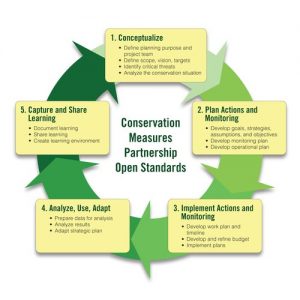Agreeing on Shared Priorities
 Our Arid Lands Initiative core team has worked together since 2009 to identify shared priorities. This process stemmed from our initial goal: to develop and cooperatively implement a coordinated strategy for the conservation of Washington’s arid lands, including shrub steppe, Palouse grasslands and those freshwater systems contained within the arid lands landscape. This coordinated strategy includes these agreed-upon components:
Our Arid Lands Initiative core team has worked together since 2009 to identify shared priorities. This process stemmed from our initial goal: to develop and cooperatively implement a coordinated strategy for the conservation of Washington’s arid lands, including shrub steppe, Palouse grasslands and those freshwater systems contained within the arid lands landscape. This coordinated strategy includes these agreed-upon components:
- Biological priorities: systems and species we are striving to conserve;
- Strategic priorities: actions necessary to conserve those priority systems and species; and
- Spatial priorities: priority areas where we must act first.
Learn more

There are myriad frameworks and tools to facilitate a conservation planning process such as ours. We selected the Open Standards for Conservation to help organize and focus our discussions to identify shared biological and strategic priorities. This process has been used extensively by The Nature Conservancy, and is similar to many of the ALI partners’ own planning processes, such as the U.S. Fish and Wildlife’s Strategic Habitat Conservation, Washington Department of Fish and Wildlife’s Conservation Initiative, and the U.S. Department of Interior’s Adaptive Management technical guidance. These similarities, the broad professional agreement on the value of the Open Standards process, and the fact that the ALI partners already had relevant in-house expertise led to our selection of this process to guide our efforts.
Individuals from the ALI partner entities joined the core team in multiple facilitated discussions and ad hoc teams to select these shared priorities. We also received valuable input throughout the process from experts and stakeholders interested in the values of the natural resources of the Columbia Plateau.
Learn more
 Our coordinated landscape conservation strategy also includes shared priority areas, where we agreed action needs to happen first. We identified shared priority areas based on the results of two scientific analyses developed specifically for the Columbia Plateau ecoregion, with ALI partnership input. One of these analyses focused on identifying and characterizing core habitat patches, and the other provided important linkages for keeping those core patches connected.
Our coordinated landscape conservation strategy also includes shared priority areas, where we agreed action needs to happen first. We identified shared priority areas based on the results of two scientific analyses developed specifically for the Columbia Plateau ecoregion, with ALI partnership input. One of these analyses focused on identifying and characterizing core habitat patches, and the other provided important linkages for keeping those core patches connected.
Learn more